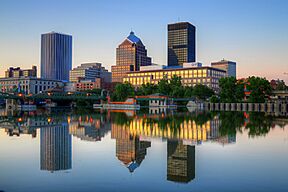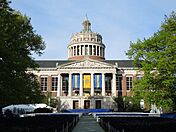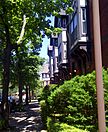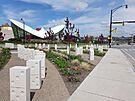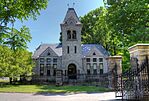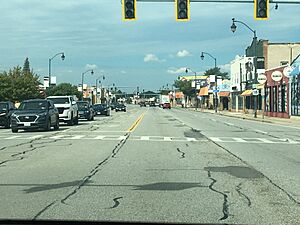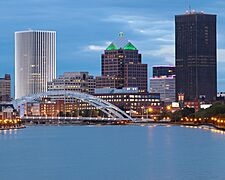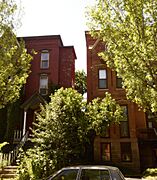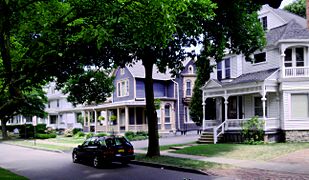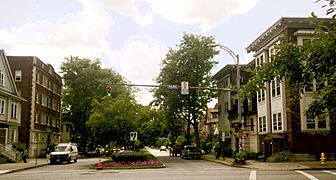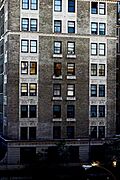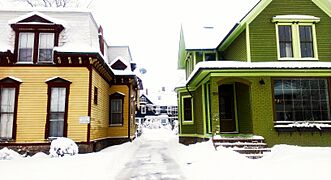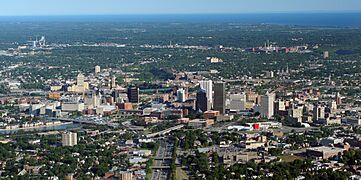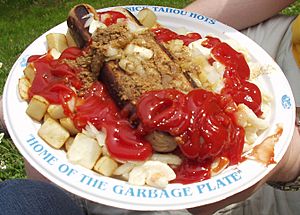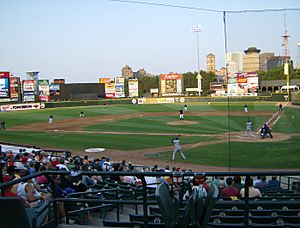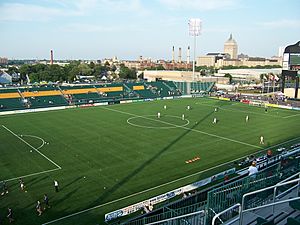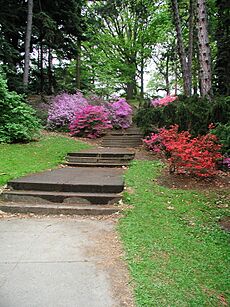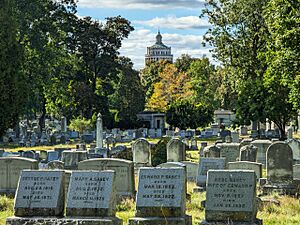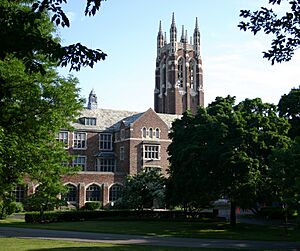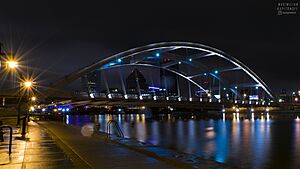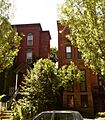Rochester, New York facts for kids
Quick facts for kids
Rochester
|
|||||
|---|---|---|---|---|---|
|
Downtown Rochester
University of Rochester
Grove Place
Mount Hope Cemetery
|
|||||
|
|||||
| Nickname(s):
"The Flour City", "The Flower City", "The World's Image Center"
|
|||||
| Country | United States | ||||
| State | New York | ||||
| Region | Western New York; Genesee Valley; Finger Lakes Region | ||||
| Metro | Rochester metropolitan area | ||||
| County | Monroe | ||||
| Founded | 1788 | ||||
| Incorporated (village) | March 21, 1817 (as Rochesterville) | ||||
| Incorporated (city) | April 28, 1834 | ||||
| Named for | Nathaniel Rochester | ||||
| Government | |||||
| • Type | Mayor–council | ||||
| Area | |||||
| • City | 37.17 sq mi (96.27 km2) | ||||
| • Land | 35.76 sq mi (92.62 km2) | ||||
| • Water | 1.41 sq mi (3.65 km2) 3.6% | ||||
| Highest elevation | 702 ft (214 m) | ||||
| Lowest elevation | 230 ft (70 m) | ||||
| Population
(2020)
|
|||||
| • City | 211,328 | ||||
| • Rank | US: 116th NY: 4th | ||||
| • Density | 5,909.45/sq mi (2,281.62/km2) | ||||
| • Urban | 704,327 (US: 62nd) | ||||
| • Urban density | 2,413.5/sq mi (931.9/km2) | ||||
| • Metro | 1,067,486 (US: 52nd) | ||||
| Demonym(s) | Rochesterian | ||||
| Time zone | UTC−05:00 (EST) | ||||
| • Summer (DST) | UTC−04:00 (EDT) | ||||
| ZIP codes |
146xx (14604=downtown)
|
||||
| Area code | 585 | ||||
| FIPS code | 36-63000 | ||||
| GNIS feature ID | 979426 | ||||
Rochester is a city in New York, United States. It is the fourth-largest city in New York. About 211,000 people lived there in 2020. The larger area around Rochester has over 1 million people.
Rochester has many nicknames. It was called "the Flour City" because of its flour mills. Later, it became "the Flower City" due to its many nurseries. It is also known as the "Imaging Capital of the World" because of its history with cameras and photography.
The city was one of the first "boomtowns" in the U.S. This means it grew very quickly. First, it was known for flour production. Then, it became a center for manufacturing. Rochester also played a big part in important social movements. These include the fight against slavery and the movement for women's right to vote.
Many famous companies started in Rochester. These include Eastman Kodak, Xerox, and Bausch & Lomb. The area became a global hub for science and technology. This was helped by universities like the University of Rochester and Rochester Institute of Technology. These schools are now a big part of the city's economy.
Rochester is also known for its culture. It has the Eastman School of Music, which is a top music school. The Rochester International Jazz Festival is also very popular. You can visit museums like The Strong National Museum of Play and the George Eastman Museum. The George Eastman Museum has the oldest photography collection in the world.
Contents
- History of Rochester
- Geography and Landscape
- Population and People
- Rochester's Economy
- Arts and Culture in Rochester
- Sports Teams
- Parks and Recreation
- Education in Rochester
- Media and News
- Transportation in Rochester
- Healthcare Services
- Famous People from Rochester
- Sister Cities
- Images for kids
- See also
History of Rochester
The Seneca Native American tribe lived in the Rochester area. They lost most of their land in 1797. Modern Rochester began to develop after the American Revolution.
New settlers from New England came to the area looking for farmland. On November 8, 1803, Colonel Nathaniel Rochester and two partners bought land along the Genesee River. They chose this spot because its three waterfalls could provide great water power. In 1817, their land joined with other areas to form the village of Rochesterville.
By 1821, Rochesterville was the main town of Monroe County. In 1823, it became known simply as Rochester. Also in 1823, the Erie Canal was completed through the city. This canal helped Rochester grow by connecting it to the Hudson River. By 1834, Rochester became a city.
Rochester was first called "the Young Lion of the West." Then it was known as the "Flour City." By 1838, Rochester made more flour than any other city in the U.S. Its population doubled in just ten years, making it America's first "boomtown".
In the mid-1800s, the flour industry moved west. Rochester then became known for its nursery businesses. This led to its second nickname, the "Flower City."
In 1847, Frederick Douglass started an anti-slavery newspaper called The North Star in Rochester. Douglass was a former slave and a powerful speaker. His newspaper helped spread ideas against slavery.
Susan B. Anthony, a leader in the women's right to vote movement, was also from Rochester. She worked for many years to help women gain the right to vote. Her home is now a National Historic Landmark.
After the Civil War, new industries grew in Rochester. George Eastman started Eastman Kodak, a famous camera company. John Jacob Bausch and Henry Lomb started Bausch & Lomb, a company known for eyeglasses. These companies created many jobs. George Eastman also gave a lot of money to the University of Rochester and its Eastman School of Music.
In the early 1900s, Rochester became a center for making men's clothing. By 1950, the city's population reached its highest point at over 332,000 people. Later in the 20th century, many factories closed. This caused the population to decrease. By 2010, it was about 210,000.
Geography and Landscape
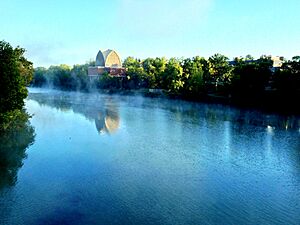
Rochester is in Upstate New York. It sits on the southern shore of Lake Ontario. The Genesee River flows right through the middle of the city. The city covers about 37 square miles. Most of this is land, with some water.
Rochester's landscape was shaped by huge sheets of ice long ago. These ice sheets created the hills you see today. They also formed Lake Ontario and the Genesee River with its waterfalls. Other features like Irondequoit Bay and the nearby Finger Lakes were also created by the ice.
The city gets its drinking water from Hemlock Lake, Canadice Lake, and Lake Ontario.
Exploring Rochester's Neighborhoods
Rochester has many different neighborhoods. Each one has its own unique feel. Here are a few examples:
- 19th Ward: This is one of Rochester's largest neighborhoods. It's known for its older homes with special features like hardwood floors. In recent years, new developments have helped improve the area.
- Charlotte:
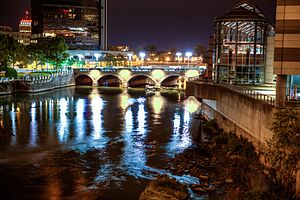 Genesee River and the historic Aqueduct Downtown
Genesee River and the historic Aqueduct Downtown
This neighborhood is right on Lake Ontario. It's home to Ontario Beach Park, also called Charlotte Beach. This is a popular spot in the summer.
- Corn Hill: This area is famous for its yearly arts festival. Many wealthy people used to live here in the 1800s. Later, the neighborhood was rebuilt and old homes were restored.
- Maplewood:
Located in the northwest, this area has a mix of large old homes and worker housing. It's known for its diverse architecture.
- Marketview Heights: This neighborhood is northeast of downtown. It's best known for the Public Market, which opened in 1905. Here, you can find groceries and other goods from local farms.
- Park Avenue: This is a very popular neighborhood. It's great for walking and has many restaurants and shops. The city's annual pride parade is held here.
- South Wedge: This neighborhood started as a home for families working on the Erie Canal. It later became a hub for small businesses. Frederick Douglass once lived in this area.
Rochester's Climate and Weather
Rochester has four distinct seasons.
- Winters are cold and often cloudy. The city gets a lot of snow, especially from lake effect snow. This happens when cold air moves over the warmer waters of Lake Ontario. Rochester is known for its heavy snowfall.
- Spring brings more rain and warmer temperatures. Sometimes, there can be late snowstorms.
- Summers are warm and sunny. They are usually comfortable, not too hot or humid.
- Autumn (fall) is known for beautiful leaf colors. Temperatures get cooler, and there is often plenty of rain.
Population and People
| Historical population | |||
|---|---|---|---|
| Census | Pop. | %± | |
| 1810 | 1,001 | — | |
| 1820 | 1,502 | 50.0% | |
| 1830 | 9,207 | 513.0% | |
| 1840 | 20,191 | 119.3% | |
| 1850 | 36,403 | 80.3% | |
| 1860 | 48,204 | 32.4% | |
| 1870 | 62,386 | 29.4% | |
| 1880 | 89,366 | 43.2% | |
| 1890 | 133,896 | 49.8% | |
| 1900 | 162,608 | 21.4% | |
| 1910 | 218,149 | 34.2% | |
| 1920 | 295,750 | 35.6% | |
| 1930 | 328,132 | 10.9% | |
| 1940 | 324,975 | −1.0% | |
| 1950 | 332,488 | 2.3% | |
| 1960 | 318,611 | −4.2% | |
| 1970 | 296,233 | −7.0% | |
| 1980 | 241,741 | −18.4% | |
| 1990 | 231,636 | −4.2% | |
| 2000 | 219,474 | −5.3% | |
| 2010 | 210,565 | −4.1% | |
| 2020 | 211,328 | 0.4% | |
| 2023 (est.) | 207,274 | −1.6% | |
| Historical Population Figures U.S. Decennial Census |
|||
In 2020, Rochester's population was 211,328. For many years, the city's population decreased. However, in 2020, it increased for the first time since 1950.
Rochester has become a major home for people from other countries. Many immigrants have come from Eastern Europe, Africa, and the Caribbean. Rochester has one of the largest communities of Puerto Ricans and Jamaicans in the United States. It also has large communities of Turkish and Polish people.
Rochester is also known for having a large deaf population. This is because it is home to the National Technical Institute for the Deaf.
Rochester's Economy
| Rank | Employer | Employees |
|---|---|---|
| 1 | University of Rochester | 31,940 |
| 2 | Rochester Regional Health | 17,297 |
| 3 | Wegmans | 13,211 |
| 4 | Paychex | 4,700 |
| 5 | Rochester Institute of Technology | 4,045 |
| 6 | L3Harris Technologies | 3,746 |
| 7 | Heritage Christian Services | 2,417 |
| 8 | Lifetime Healthcare Companies | 2,209 |
| 9 | Angels in Your Home | 2,082 |
| 10 | Tops Markets | 1,998 |
Rochester used to be a big manufacturing center. Companies like Bausch & Lomb, Kodak, and Xerox were very important. However, many factories closed in the late 1900s.
Today, the city's biggest employers are its universities and hospitals. The University of Rochester is the top employer. Other major employers include Rochester Regional Health and the Rochester Institute of Technology.
A new high technology industry has grown in Rochester. This is helped by the universities and new startup businesses. Rochester is still focused on imaging and optics. This is thanks to programs at the University of Rochester and Rochester Institute of Technology.
Other important companies in Rochester include Constellation Brands, a beverage company, and Paychex, a payroll company. The supermarket chain Wegmans also started here.
Arts and Culture in Rochester
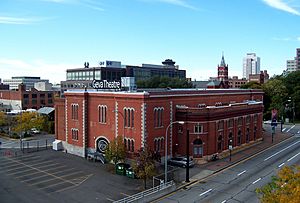
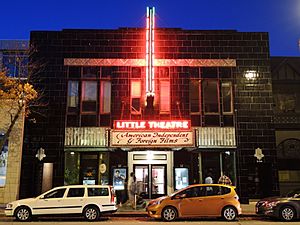
Rochester has many cultural places and events. These include:
- The Geva Theatre Center, which is the city's largest professional theater.
- The Rochester Philharmonic Orchestra, a well-known music group.
- The Eastman School of Music, one of the best music schools in the country. Its auditorium hosts many musical events.
Museums to Explore
There are many interesting museums in the Rochester area:
- George Eastman Museum: This museum is dedicated to photography and film. It has the oldest photography collection in the world.
- Memorial Art Gallery: An art museum with many different collections.
- Rochester Museum and Science Center: A great place to learn about science and local history. It also has the Strasenburgh Planetarium.
- The Strong National Museum of Play: This museum is all about play. It has the National Toy Hall of Fame.
- Susan B. Anthony House: You can visit the home of the famous women's rights leader.
Fun Festivals and Events
Rochester hosts many festivals each year:
- Lilac Festival: Held at Highland Park, this festival celebrates the park's huge collection of lilac flowers. It includes a parade and live music.
- Rochester International Jazz Festival: This is one of the largest jazz festivals in the U.S. It brings many musicians and visitors to downtown Rochester in June.
- Corn Hill Arts Festival: Held in July, this festival celebrates art in the historic Corn Hill neighborhood.
- Rochester Fringe Festival: This festival in September features many different types of performances and art.
Local Food and Drinks
Rochester has some unique local foods:
- White Hot: This is a special type of hot dog made by local companies like Zweigle's.
- Garbage Plate: This famous dish from Nick Tahou Hots includes macaroni salad, home fries, and hot dogs or cheeseburgers. It's all topped with mustard, onions, and a special meat sauce. Many local restaurants make their own versions.
The Genesee Brewing Company is based in Rochester. They have a fun tradition of building a Christmas tree out of beer kegs in December. Other local food places include Abbott's Frozen Custard and Wegmans supermarkets.
Sports Teams
Rochester has several professional sports teams:
- Rochester Red Wings: A baseball team that plays in the IL.
- Rochester Americans: An ice hockey team in the AHL.
- Rochester Knighthawks: An indoor lacrosse team in the NLL.
- Flower City Union: A soccer team that plays in the NISA.
The Rochester Royals, a basketball team, won the NBA title in 1951. Rochester also has a rich golf history and has hosted many professional tournaments.
Parks and Recreation
Rochester has a beautiful park system. It was designed by a famous landscape architect named Frederick Law Olmsted in the 1890s. He wanted to keep natural areas for people to enjoy. The main parks include:
- Genesee Valley Park
- Highland Park
- Maplewood Park
- Seneca Park, which is home to the Seneca Park Zoo.
Later, more parks were added, like Cobb's Hill Park and Durand Eastman Park. Many of the city's parks are along the Genesee River. You can explore them using the Genesee Riverway Trail. The city also has many recreation centers, playgrounds, and sports fields.
Education in Rochester
Schools for Kids and Teens
The Rochester City School District serves all public elementary, middle, and high schools in the city. There are 14 public high schools, including:
- East High School
- Edison Career & Technology High School
- James Monroe High School
- School of the Arts
Rochester also has several free charter schools and private schools.
Colleges and Universities
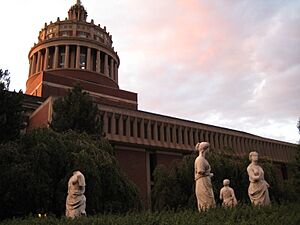
Rochester has many colleges and universities. These schools help the local economy grow.
- University of Rochester: This is the oldest and most important university in the area. It is a top research center. It includes a nursing school, a business school, and the famous Eastman School of Music.
- Rochester Institute of Technology (RIT): Another major university, known for its technology and art programs.
- Monroe Community College: A two-year college with a campus downtown.
Public Libraries
The Rochester Public Library is located downtown. It is part of the larger Monroe County Library System. You can get a library card for free if you live in Monroe County. This card works at all eleven branch libraries in the city and other libraries in the county.
Media and News
The Democrat and Chronicle is Rochester's main daily newspaper. There are also other local publications for specific interests.
Rochester has several local TV and radio stations. The WXXI Public Broadcasting Council provides public television and radio programs. They also own City Magazine and the Little Theater.
Some movies have been filmed in Rochester, like The Amazing Spiderman 2.
Transportation in Rochester
Getting Around by Air, Water, and Rail
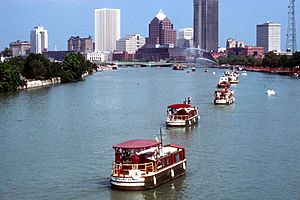
- Air Travel: Rochester is served by the Frederick Douglass Greater Rochester International Airport (GRIA). Many major airlines fly from here. The airport was renovated in 2016 to make it more modern.
- Waterways: The Port of Rochester on Lake Ontario handles marine freight. The Erie Canal also crosses the Genesee River in the city. In the past, passenger ferries traveled between Rochester and Canada on Lake Ontario.
- Buses and Trains: Local bus service is provided by the Rochester-Genesee Regional Transportation Authority (RGRTA). Long-distance bus service is available from Greyhound and Trailways. Train service is provided by Amtrak at the Louise M. Slaughter Rochester Station.
Rochester used to have a light rail subway system from 1927 to 1956. It was one of the smallest cities in the world to have a subway. After it closed, parts of the subway tunnel were filled in. Today, some parts of the tunnel are used by graffiti artists.
Major Roads and Highways
Rochester has a system of expressways that help people travel quickly.
- The New York State Thruway (I-90) has three exits for Rochester.
- The Outer Loop goes around the city limits.
- The Inner Loop used to circle downtown. Part of it was removed between 2014 and 2017.
- I-390 runs north and south through the western suburbs.
- I-490 runs east and west through Rochester. It includes the Frederick Douglass–Susan B. Anthony Memorial Bridge over the Genesee River.
- I-590 runs north and south through the eastern suburbs.
Healthcare Services
Most healthcare in Rochester is provided by the University of Rochester Medical Center (URMC) and Rochester Regional Health (RRH). Major hospitals include:
- Highland Hospital
- Rochester General Hospital
- Strong Memorial Hospital, which includes the Golisano Children's Hospital for kids.
- Unity Hospital
Famous People from Rochester
- See List of people from Rochester, New York
Many notable people were born or lived in Rochester. These include:
- Susan B. Anthony: A social reformer and women's rights activist.
- Frederick Douglass: An African-American social reformer and abolitionist.
- George Eastman: The founder of Kodak.
Sister Cities
Rochester has twelve sister cities around the world. These cities are connected by a special walkway over the Genesee River called the Sister Cities Bridge.
 Rennes, France (1958)
Rennes, France (1958) Würzburg, Germany (1964)
Würzburg, Germany (1964) Caltanissetta, Italy (1965)
Caltanissetta, Italy (1965) Rehovot, Israel (1972)
Rehovot, Israel (1972) Kraków, Poland (1973)
Kraków, Poland (1973) Bamako, Mali (1975)
Bamako, Mali (1975) Waterford, Ireland (1983)
Waterford, Ireland (1983) Veliky Novgorod, Russia (1990)
Veliky Novgorod, Russia (1990) Hamamatsu, Japan (1996)
Hamamatsu, Japan (1996) Puerto Plata, Dominican Republic (1997)
Puerto Plata, Dominican Republic (1997) Xianyang, China (2007)
Xianyang, China (2007) Alytus, Lithuania (2009)
Alytus, Lithuania (2009)
Images for kids
See also
 In Spanish: Rochester (Nueva York) para niños
In Spanish: Rochester (Nueva York) para niños


